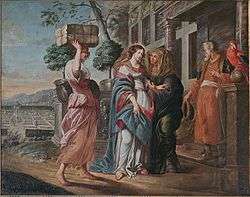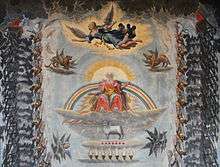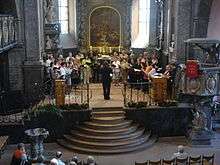Unionskirche, Idstein
| Unionskirche | |
|---|---|
|
Interior facing the altar | |
| 50°13′8″N 8°16′0″E / 50.21889°N 8.26667°ECoordinates: 50°13′8″N 8°16′0″E / 50.21889°N 8.26667°E | |
| Location | Idstein |
| Country | Germany |
| Denomination | Protestant Church in Nassau |
| Website |
www |
The Unionskirche (Union Church) is the active Protestant parish church of Idstein, a major town in the German Rheingau-Taunus District. Idstein was a residence of the Counts of Nassau. The church building in the center of the historic "Altstadt" (old town) dates back to the 14th century. Its interior was adapted in the 17th century to become a Lutheran "Predigt- und Hofkirche" (sermon and court church). The most prominent decoration in the church is the series of 38 paintings by the Flemish painter Michael Angelo Immenraedt, an exponent of Flemish Baroque painting.
The church was named Unionskirche in 1917 to commemorate the union of Lutheran and Reformed Protestants in the Duchy of Nassau in August 1817, the first of its kind (before the Prussian Union in September of the same year). The Unionskirche is a recognized monument under the Hague Convention. It is used by the Protestant Congregation, and it is open to other institutions as a concert venue.
History
Collegiate St. Martin
Remnants in the tower prove that a Romanesque church existed before 1287 at the same location. The oldest part of today's church is the 13th century base of the north tower bordering on the choir. The present church was built from 1330 to 1350 under Gerlach, count of Nassau, as the church for a Collegiate of six canons, founded in 1333. Collegiate and church were dedicated to St. Martin.[1]
Protestant church
Idstein became Protestant during the Reformation. After the Thirty Years' War, the church was transformed into a representative Baroque "Predigt- und Hofkirche" (sermon and court church) by Johann of Nassau-Idstein (1603–77). The rebuilding lasted from 1665 to 1677. Whereas the basilica nave was kept, the church was expanded to the west, the walls were raised resulting in flatter roofs. Most of the pillars were removed, oval windows were installed in the clerestory, and portals rounded.[1] The interior was changed from 1665. Arnold Harnisch (Mainz) and Hans Martin Sattler (Idstein) removed the vaults and built "Marmorarkaden" (arcades of marble). Galleries were installed on three sides in 1675.

Certain members of the society had reserved seats, chairs for government, council, secretary, jurisdiction, principal, citizen (Herrschafts-, Rats-, Sekretär-, Gerichts-, Vorsteher-, Bürgerstuhl). Plaques on the respective balustrades show bible quotations relevant for the position.[1]
In 1714, the tower was heightened and in 1830 an octagonal spire with gables was added. The buttressed wall of the chancel dates from 1340–50. In 1725, dormer windows were added to provide better lighting for the gallery.[1]
Paintings
A unique feature of the church are 38 oil paintings, which cover the ceiling of the nave and the upper part of the walls completely.[1] This use of paintings as an architectural feature is unusual for a Protestant church. The paintings, exclusively on Biblical topics, were created from 1673 to 1678 by Michael Angelo Immenraedt from Antwerp and his assistant Johannes Melchior Bencard. Three paintings are based on designs by Joachim von Sandrart, five were executed by his nephew Johann von Sandrart.[1] Several paintings are based on well-known works by Rubens, for example The Wedding at Cana[2] on the south wall largely based on Rubens's painting The Feast of Herod which hangs today in the National Gallery of Scotland in Edinburgh.[3]

The sequence of paintings aims to tell the Gospel stories to a partly illiterate congregation. The Biblical figures are depicted in courtly Baroque garments. The painting "Heimsuchung" (Visitation) shows Mary arriving with a servant who carries her cases on his head. Saint Elisabeth’s residence with its formal garden in the background resembles the Idstein residential palace of Johann of Nassau-Idstein, the construction of which was commenced in 1646.[4] The paintings in the center of the ceiling all have a topic and use Baroque optical illusionism to make the viewer look up, from altar to the back: "Verklärung Christi am Tabor" (The Transfiguration), Kreuzaufrichtung (elevation of the cross), Auferstehung (The Resurrection), Kreuzabnahme (The Deposition), Himmelfahrt (The Ascension), and "Johannes auf Patmos sieht den Himmel offen und die Engel mit dem Evangelium" (The Vision of St. John on Patmos, literally: John on Patmos sees heaven open and the angels with the Gospel).[2]
Fittings and furniture
The main altar, of marble, was built in 1676 by Arnold Harnisch. It shows a painting of the Last Supper from the end of the 17th century. The marble pulpit was erected in 1673 by Christian Gaßmann, the baptismal font, also of marble, in 1675 by Martin Sattler.[1]
Johann, infamous for his Persecution of witches (Hexenverfolgung) as late as 1676,[5] died shortly before the reconstruction of the church was completed. Franz Matthias Hiernle erected an epitaph for Georg August Samuel von Nassau-Idstein (1665–1721) and his family, his wife Henriette Dorothea and their children. It was designed by Maximilian von Welsch and placed left of the altar.[1]

A 1725 fresco above the altar by Maximilan Pronner (Gießen) shows the vision of St. John in the Book of Revelation, Worthy is the Lamb (Revelation 5:12ff) that Handel painted in music to conclude his oratorio Messiah. In 1726, additional wooden pillars in the shape of palm trees were installed. The lattice separating the elevated chancel was made by Johann Urban Zais.[1]
The crystal chandeliers from the early 19th century were originally in the old Kurhaus Wiesbaden.[1]
Church Union
The church was simply called Stadtkirche (Town Church). The few remaining Catholics of Idstein were not permitted to hold services until 1806. Then they were granted the right to use the "Schlosskapelle" (Palace Chapel) until 1888, when they could move to their own church. The Stadtkirche was named Unionskirche in 1917, to commemorate the centennial of the union of Lutheran and Reformed Protestants in the Duchy of Nassau in 1817 in the so-called "Nassauische Union", to form the Evangelische Kirche in Nassau (Protestant Church in Nassau). It was the first such union in Germany.[6][7]
Present day
The church is used by the "Evangelische Kirchengemeinde Idstein" (Protestant Congregation Idstein), a member of the Evangelische Kirche in Hessen und Nassau. It is located in today's pedestrian area of the town. The congregation has been on good ecumenical terms with the Catholic St. Martin. Regular "Ökumenische Gottesdienste" (ecumenical service) are held on the first Sunday in Advent (in St. Martin) and on Pentecost Monday (Unionskirche).
The congregation has participated in the civic partnership between Idstein and Moshi, founded by Werner Schuster, whose wife Gisela Schuster conducts the Flötenensemble (recorder ensemble) at the church. Major restoration is under way for the celebration of 200 years of the church union in 2017.
Assessment
The "Landesamt für Denkmalpflege in Hessen", taking care of historic monuments in the state of Hesse, notes about the interior of the Unionskirche that firstly it follows the principles of a Protestant concept of church design, as they were first exemplified in the "Hofkirche zu Torgau" in 1544,[1] with Martin Luther's approval. Secondly, the paintings are a distinct part of the architecture, as a rare and comparatively late example of "evangelische Laiendogmatik" (Protestant lay teaching) by painting. It is the first and notable independent creation of a church building (erste und bedeutende eigenständige kirchliche Bauschöpfung) in Nassau after the Thirty Years' War.[1]
Music
Church music


The organ, built in 1783 by Stumm, was replaced in 1912 by an instrument of Walcker, but retaining the historic case (Prospekt).[1]
The church choir, conducted by Edwin Müller, was named Idsteiner Kantorei in 1972 and started to perform two major concerts a year, in addition to services and concerts in smaller churches of the region.[8] Since 2003 the cantor has been Carsten Koch, who is also professor at the Musikhochschule Frankfurt. In addition to the standard repertoire, he selected rarely performed works such as Schumann's Missa sacra on 9 November 2008.[9] In 2011 they performed Mendelssohn's Lobgesang, with Christiane Kohl as a soloist.[10]
Other musical groups at the Unionskirche are a Kinderkantorei (children's chorale), Jugendkantorei (youth chorale), a Gospelchor (Gospel choir), a Flötenensemble (recorder ensemble) and a Posaunenchor (trombone choir).
Concerts
The Unionskirche is a venue of the Rheingau Musik Festival. The Festival’s emphasis is on vocal music, and has presented works such as a recital of Elizabeth Parcells and concerts of the vocal ensembles Chanticleer, ensemble amarcord and Die Singphoniker, among others.
In 2000 the Idsteiner Bachtage were held as an ecumenical collaboration between the Unionskirche and St. Martin. Concerts at the Unionskirche included the Brandenburg Concertos, cantata BWV 34 and the Missa in A.[11]
In 2003 the Unionskirche hosted the annual choral concert of St. Martin, because St. Martin could not be used due to restoration. In keeping with the interior design, works of George Frideric Handel were performed, including his Utrecht Te Deum and Jubilate and a Gloria, rediscovered in 2001[12] and performed by coloratura soprano Katia Plaschka.[13]
Carsten Koch established a series of symphony concerts on the annual "Tag des offenen Denkmals" (European Heritage Day), beginning in 2004 a cycle of the symphonies of Beethoven.[14] It was completed in 2012 with the Ninth Symphony.[15] This concert on 9 September, during a "Jubiläumswoche der Kirchenmusik" (Anniversary Week of Church Music), was also part of the celebration of anniversaries, 100 years of the Walcker organ and 40 years of the Idsteiner Kantorei.[16][17] During the anniversary year, the Idsteiner Kantorei performed Bach's St John Passion and, as part of a service", his cantata for Easter Christ lag in Todes Banden, BWV 4.[16]
Burials
- Walram IV, Count of Nassau-Idstein
- Philip I, Count of Nassau-Wiesbaden-Idstein
- John, Count of Nassau-Idstein
- George August, Count of Nassau-Idstein
- Charles Louis, Count of Nassau-Saarbrücken
- Adolph II, Count of Nassau-Wiesbaden-Idstein
- Balthasar, Count of Nassau-Wiesbaden-Idstein
- John Louis I, Count of Nassau-Wiesbaden-Idstein
Literature
- Göbel, Karl G.: Die Bildzyklen in der Idsteiner Stadtkirche (Unionskirche) und ihre Bedeutung, in: NassA 118 (2007), p. 341–384
- Schmidt, Karl Heinz: Grüfte und Sarkophage in der Unionskirche zu Idstein, in: NassA 107 (1996), p. 79
References
- 1 2 3 4 5 6 7 8 9 10 11 12 13 "Evangelische Pfarrkirche (Unionskirche)" (in German). Denkmalpflege Hessen. Retrieved 9 June 2011.
- 1 2 "Anordnung der Wand- und Deckenbilder in der Unionskirche Idstein (Layout of the wall- and ceiling-paintings in the Union Church, Idstein)" (in German). Evangelische Kirchengemeinde Idstein. Retrieved 15 June 2011.
Click on numbered descriptions to see images, Wedding at Cana is #19.
- ↑ "The Feast of Herod". National Galleries of Scotland Online Collections. Retrieved 5 July 2012.
- ↑ "Graf Johannes von Nassau-Idstein" (in German). nassau-info.de. Retrieved 15 June 2011.
- ↑ "Die Hexenverfolgung in Idstein" (in German). nassau-info.de. Retrieved 15 June 2011.
- ↑ "Propstei Süd-Nassau" (in German). Protestant Church in Hesse and Nassau. Retrieved 15 June 2011.
- ↑ "Staatlicher Dirigismus und neue Gläubigkeit (Die Kirche im Herzogtum Nassau)" (in German). nassau-info.de. Retrieved 15 June 2011.
- ↑ "Idsteiner Kantorei" (in German). Idsteiner Kantorei. Retrieved 14 June 2011.
- ↑ "Missa sacra" (in German). Schott. Retrieved 14 June 2011.
- ↑ Richard Hörnicke (8 February 2011). "Lobgesang auf Kochs Bleiben" (in German). Wiesbadener Tagblatt. Retrieved 9 February 2011.
- ↑ Idsteiner Bachtage (in German). Idsteiner Bachtage. 28 May 2000.
- ↑ "The Newly Discovered Musical Composition by Handel: Gloria in excelsis Deo". gfhandel.org. Retrieved 27 July 2011.
- ↑ Georg Friedrich Händel Utrechter Te Deum Utrechter Jubilate. St. Martin, Idstein. 29 June 2003.
- ↑ "Konzert in der Unionskirche" (in German). Wiesbadener Kurier. 11 September 2010. Retrieved 12 June 2011.
- ↑ Wenda, Manuel (11 September 2012). "Beethoven-Zyklus in Idstein beendet" (in German). Wiesbadener Kurier. Retrieved 11 September 2012.
- 1 2 "Jahr der Kirchenmusik / Besondere Jubiläen und außergewöhnliche Konzerte in Idstein" (in German). Wiesbadener Tagblatt. 17 February 2012. Retrieved 5 July 2011.
- ↑ "Newsletter Nr. 83 / Woche der Kirchenmusik II" (PDF) (in German). Evangelischen Arbeitsgemeinschaft Bad Schwalbach und Idstein. 20 June 2012. p. 3. Retrieved 5 July 2012.
External links
-
 Media related to Unionskirche Idstein at Wikimedia Commons
Media related to Unionskirche Idstein at Wikimedia Commons - "Unionskirche: history". Evangelische Kirchengemeinde Idstein (in German).
- Ausflüge Taunus III Hintertaunus und Lahn (in German)
- Idstein, Unionskirche (Protestant Church) flickr.com
- Unionskirche, nassau-info.de (in German)